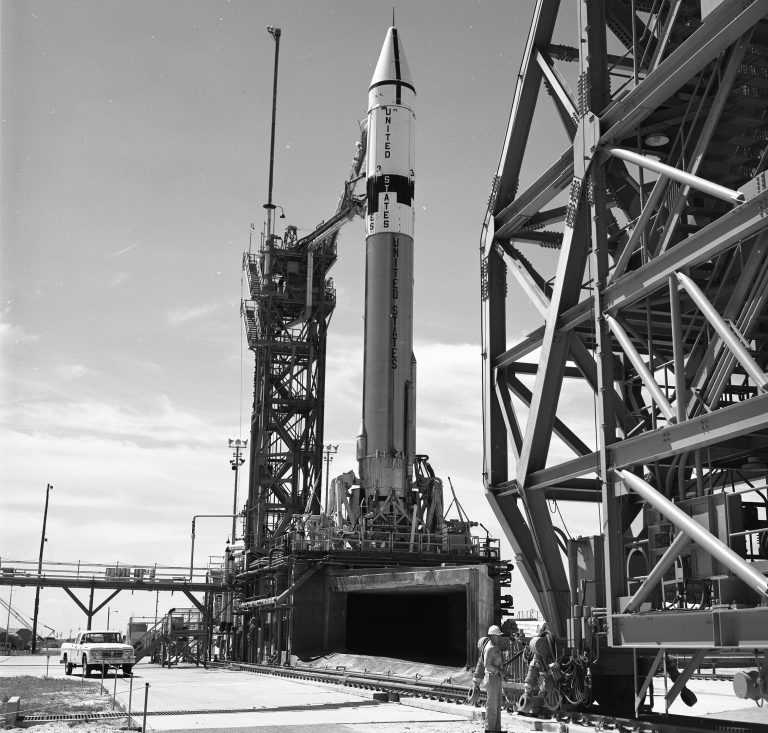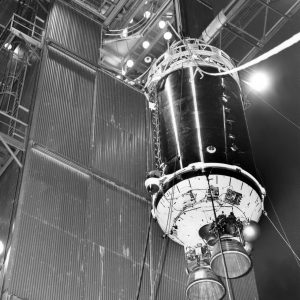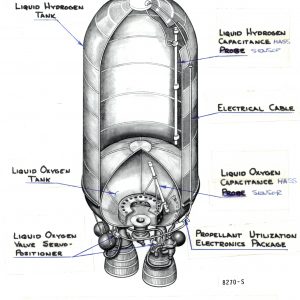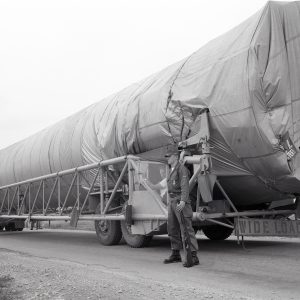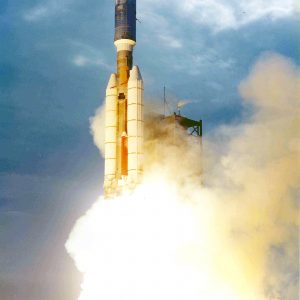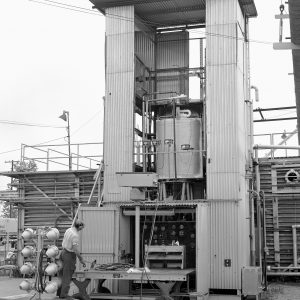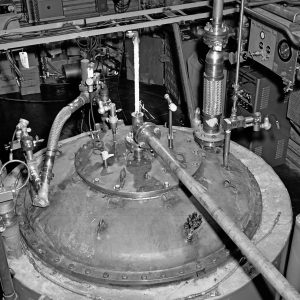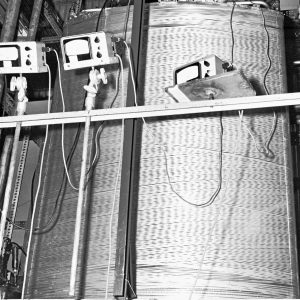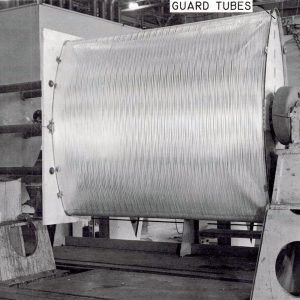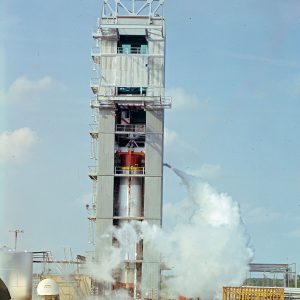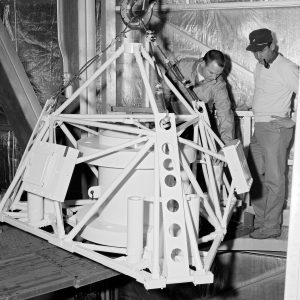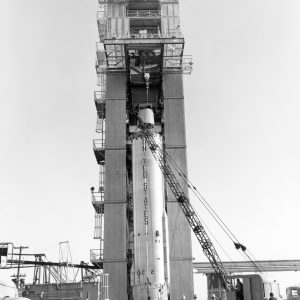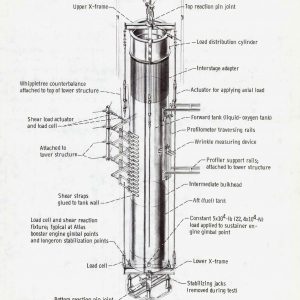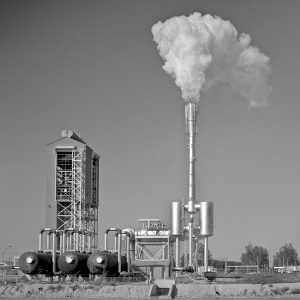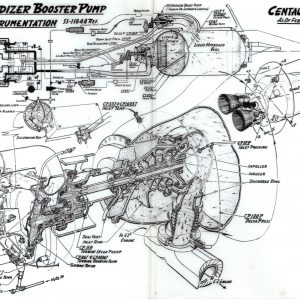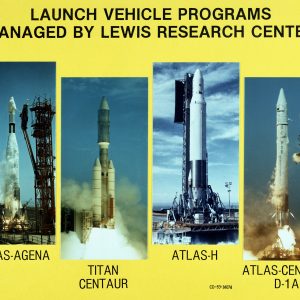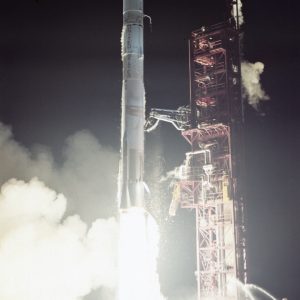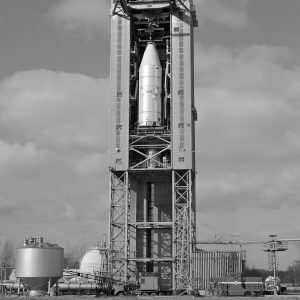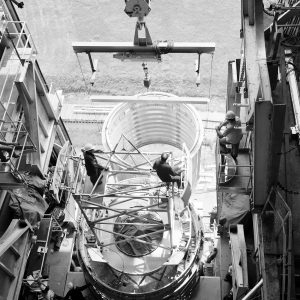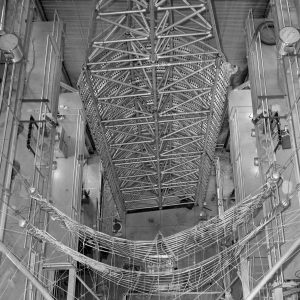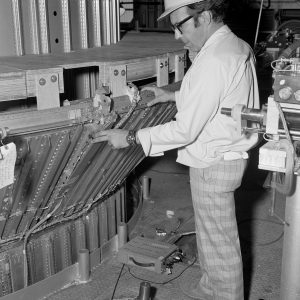Centaur Program
Centaur was a 15000-pound thrust second-stage rocket designed for the military in 1957 and 1958 by General Dynamics. It was the first major rocket to use the liquid hydrogen technology developed by Lewis in the 1950s.
The Centaur suffered numerous problems before being transferred to Lewis in 1962. Lewis was able to rectify those problems, and Centaur performed key missions paving the way for the Apollo landings on the Moon. Successive generations of Centaur vehicles have since launched hundreds of spacecraft and satellites. The Rocket Systems Area made several contributions to the Centaur Program.
The Centaur Program
General Dynamics designed the Centaur rocket in 1957 and 1958 as a second-stage for its Atlas missile. The vehicle was powered by two Pratt & Whitney liquid-hydrogen-fueled RL–10 engines, the first commercially produced hydrogen engines. NASA sought to use the Atlas-Centaur to send Surveyor spacecraft to explore the lunar surface before the Apollo landings.
The Centaur Program was originally managed by Werner von Braun at the Army Ballistic Missile Agency (the future Marshall Space Flight Center). There was internal debate regarding the selection of the upper-stage for the new Saturn booster. A committee led by Abe Silverstein reviewed the options in 1959 and concluded that a stage using high-energy propellants such as liquid hydrogen was the only solution. Von Braun was skeptical but approved their decision. Marshall was preoccupied with the Saturn booster and wary of Centaur’s unconventional design. The new vehicle suffered a number of developmental problems that culminated with the explosion of its first launch attempt in 1962.
Following congressional hearings and internal NASA deliberations, the Centaur Program was transferred to Lewis in September 1962. Silverstein was now the NASA Lewis Research center director and would personally oversee the program. Numerous test facilities at Lewis’ main campus and Plum Brook Station were built or modified specifically for Centaur. After several years of intensive work, an Atlas-Centaur successfully launched the first Surveyor in 1966. NASA and General Dynamics developed a second generation of Centaur in the mid-1960s and was also paired the vehicle with the Titan booster. Centaur continues to serve as the Nation’s primary space tug.
Documents
- Taming Liquid Hydrogen: The Centaur Upper-Stage Rocket
- Centaur Launches (1962-2012)
- Centaur Program Overview (1963)
- History of Centaur Press Release (1984)
Propellant Tank Insulation
Centaur required insulation to keep the cryogenic liquid-hydrogen fuel from evaporating during the launch. General Dynamics designed foam insulation panels that were jettisoned as the vehicle exited the atmosphere. The failure of those panels caused the loss of the first Atlas-Centaur launch. Lewis researchers explored a new insulation system that would remain intact throughout the mission. They analyzed several different options before pursuing a system that used a Mylar (Dupont Tejjin Films) and aluminum wrap to affix foam panels to the Centaur tank. The researchers first tested the performance of the system on a small tank at the Rocket Systems Area’s J–3 and J–4 sites under simulated ground hold and launch conditions. They then applied the insulation to a full-scale tank and tested it at J–4. This constrictively wrapped insulation performed as well as, and was safer than, the existing system, but General Dynamics retained the jettisonable panels until the 1990s.
Reports
- External Insulation System for Hydrogen Tanks (1965)
- Ground Hold Study of Hydrogen Tank Insulation (1965)
Structural Dynamics
Rocket vehicles experience substantial vibrations during a launch. These vibrations can shake components loose, compromise the vehicle’s structure, or disrupt the guidance system. After this phenomena caused the failure of numerous missiles, Lewis engineers designed the Dynamics Stand (E Stand) to test missiles in simulated launch conditions. Researchers used E Stand almost exclusively to test the new Atlas-Centaur vehicle during the 1960s.
The Atlas and Centaur were both lightweight vehicles that utilized pressurized balloon-like propellant tanks. There was concern regarding their structural integrity during the severe conditions experienced during a launch. Researchers subjected the Atlas with a dummy Centaur vehicle to maximum loads and vertical vibrations to verify its strength before the second Atlas-Centaur launch in November 1963. They added an actual Centaur stage for a series of lateral vibration tests with and without a mockup Surveyor spacecraft. Researchers then worked with General Dynamics to demonstrate that the vehicle was stronger than the design specifications indicated. They applied enough force to damage the Atlas tank, but the outer skin retained its seal and pressurization. They then attempted to break the vehicle but could not. The Atlas-Centaur proved to be significantly more robust than originally believed.
Documents
- Atlas-Centaur-Surveyor Longitudinal Dynamics Tests
- Experimental Lateral Bending of Atlas-Centaur-Surveyor
- Bending Strength of Atlas Booster Beyond Skin Wrinkling
Improving the Centaur Vehicle
After proving itself with several Surveyor missions, NASA decided in the late 1960s to use the Atlas-Centaur to launch a series of space probes and satellites. Lewis worked with General Dynamics to improve the vehicle, referred to as the Centaur D or the Advanced Centaur. As part of this process, engineers sought to streamline the flow system by removing the boost pumps.
Tests in the High Energy Rocket Engine Research Facility (B-1) sought to analyze the pressurization and outflow performance of the vehicle’s hydrogen and oxygen tanks. The program began in March 1968 with a series of outflow tests. In the fall of 1968 the second phase of testing focused on tank pressurization and a redesign of the propellant tank duct. The final series of tests in early 1969 analyzed a flight-type liquid hydrogen pressurization panel.
The Advanced Centaur tests led to a redesign of the tank insulation that eventually became the standard for the Centaur D, a launch vehicle that performed 65 successful missions between 1966 and 1989. The tests were also an important early step in the eventual elimination of the boost pumps from the Centaur feed system. Follow-up full-scale tests in the Spacecraft Propulsion Research Facility (B–2) led to the eventual removal of the boost pumps from the design, which resulted in a simpler and less expensive.
Documents
- Centaur D-1A pamphlet (1973)
- Helium Requirements for Pressurization of Centaur Hydrogen Tank (1969)
- Helium Requirements for Pressurization of Centaur Oxygen Tank (1970)
Centaur Standard Shroud
NASA introduced a series of new space exploration missions for the 1970s, including the interplanetary Voyager spacecraft and the Viking Mars landers. The $1 billion Viking Program was vital to NASA’s future. Viking was the heaviest payload ever attempted in a launch and was over three times the weight of Atlas-Centaur’s previous heaviest payload. To accomplish these heavy launches, NASA paired Centaur with the Titan III launch vehicle. General Dynamics modified Centaur to fit Titan. The biggest change was a new faring called the Centaur Standard Shroud (CSS).
The conical two-piece covering encapsulated the payload to protect it against adverse conditions and improve the aerodynamics as the launch vehicle passed through the atmosphere. The shroud was jettisoned as the vehicle reached the edge of space. Even a minor error in the jettison system could result in a launch failure. NASA used the Nuclear Rocket Dynamics and Control Facility (B-3) stand to test the shroud, its insulation, the Centaur ground-hold purge system, and the hydrogen tank venting system.
The B-3 tests commenced in the spring of 1973. Structural load tests determined the ultimate flight loads on two axes, established the Centaur load sharing, and combined spacecraft loads with the CSS. The next series of unlatch tests, run at cryogenic temperatures, determined the level of propellant boiloff during launch holds, verified the vent system capacity, and determined separation loads and clearances. The final series included jettison tests run both at sea level and simulated altitude. Follow-up proof tests were run in the Space Power Facility in early 1974.
The CSS performed flawlessly during the August 20 and September 9, 1975 Viking launches, and the missions were huge successes. Viking 1 and 2 operated on the Martian surface into the early 1980s. The twin Voyager launches in 1977 were just as successful. After visiting a series of planets in the outer solar system, the spacecraft exited the solar system and continue to provide researchers with data today.
Documents
- Centaur Standard Shroud B-3 Setup
- CSS Cryogenic Unlatch Tests (1973)
- Centaur Standard Shroud articles (1972)
- CSS Static Ultimate Load Structural Tests (1975)
- Titan/Centaur Viking B Flight Report (1976)
- Titan/Centaur Voyager Flight Data Report (1977)
- Centaur Launched a Generation of Interplanetary Missions (2013)

